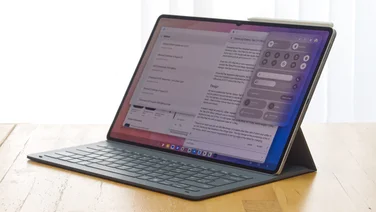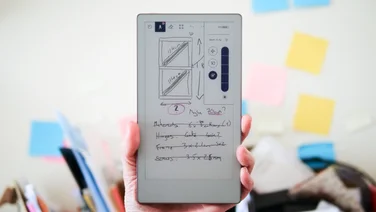To help us provide you with free impartial advice, we may earn a commission if you buy through links on our site. Learn more
- Apple iPad 10.2in (2019) review: What you need to know
- Apple iPad (10.2in) review: Price and competition
- Apple iPad (2019) review: Design and key features
- Apple iPad (2019) review: Keyboard and Apple Pencil
- Apple iPad (2019) review: Display
- Apple iPad (2019) review: Performance
- Apple iPad 10.2 (2019) review: iPadOS
- Apple iPad 10.2in (2019) review: Verdict













- Thin and light
- IPadOS is a huge improvement
- Powerful enough
- Has the same chip as an iPhone 7
- Smart Keyboard is way too expensive
The Apple 10.2in iPad is an update to a product I’ve been recommending to friends and family for some time now. They ask: “What laptop do you recommend for around £300 to £400?” My answer is always: “Why not consider buying an iPad and a keyboard instead?”
Good battery life, great performance and a top-quality screen go together to make for a product that, in most instances, will be far superior to a Windows 10 laptop at a similar price. All you need to do is add a keyboard, and you’re good to go.
READ NEXT: Apple iPhone 11 review
Apple iPad 10.2in (2019) review: What you need to know
As if in acknowledgement of the iPad’s rising status as an all-round productivity tool, Apple has now made that easier to do with the latest edition of its cheap and cheerful tablet with the addition of its “Smart Connector” keyboard interface.
This three-pin magnetic connector is the same as found on the previous-generation iPad Pro tablets and it means you can add Apple’s Smart Keyboard for a full laptop-like experience. This is actually the first time you’ve been able to do this on Apple’s cheapest, non-Pro tablet.













Next is a bigger screen, which has grown from 9.7in to 10.2in and, naturally, the tablet comes with Apple’s new iPadOS operating system, which at long last adds a proper desktop web browser and the ability to transfer files to and from external drives, among other useful tools.
Apple iPad (10.2in) review: Price and competition
You probably won’t be surprised to discover that the price has risen in line with the iPad’s new-found capabilities. It’s only gone up by £20, though, from £329 to £349 for the 32GB model, with the 128GB model costing £449.
With the Smart Keyboard cover costing £159, that puts a full, laptop-style iPad at £508, which is a bit much but, fortunately, you don’t have to buy the official Apple keyboard. Logitech’s Rugged Folio and Slim Folio cost £120 and £90 respectively and do largely the same job, although they work over Bluetooth, not the Smart Connector.
As far as alternatives go, the iPad’s main competitor is the Microsoft Surface Go, which runs Windows 10. This is a touch more expensive at £369 for the tablet but the add-on keyboard is only £99, so the overall cost runs to a less expensive £468. This model comes with double the storage of the iPad (although it’s only pretty slow eMMC storage), an Intel Pentium Gold CPU and a marginally smaller 10in IPS display.\
Apple iPad (2019) review: Design and key features
If you’ve ever laid eyes on an iPad Air, an iPad mini 5, an iPad Pro 9.7 or 10.5 then you’ll recognise the stylings of the new 2019 iPad. It has a 4:3 aspect ratio screen surrounded by fairly broad black bezels with a Touch ID fingerprint reader below the screen and a webcam above it (assuming you’re holding the tablet in portrait orientation).
It’s a very slim and light device, measuring 7.5mm front to back and weighing 483g (or 493g for the cellular model) but there’s no getting away from the fact that, in a world where even budget smartphones now have edge-to-edge displays, it’s a fairly staid look.
The big new feature, from a hardware point of view, is the magnetic, three-pin Smart Connector, which sits on the left-hand side of the tablet, and provides both power and data connectivity for add-on keyboards. All the rest of the buttons and features are in the same places as they have been for years: the power and volume keys are on the edges at the top right corner, with the Lightning connector and speaker grilles on the bottom and the rear camera is in the top left corner.













Incidentally, this camera is still the same 8-megapixel unit as found on the previous model and the front-facing camera hasn’t changed either – it’s still a fairly underwhelming 1.2-megapixel shooter.
Apple iPad (2019) review: Keyboard and Apple Pencil
It might be a tad pricey but the Smart Keyboard Folio cover that’s designed to accompany the 10.2-inch Apple iPad is the way to go if you want the most comfortable typing experience. Its unusual textured keys have a decent amount of travel to them, good separation and a surprising amount of resistance and positive action.













I’d quite like it to have some form of touchpad but in the absence of proper mouse support in iPadOS (mice work but this is only officially an accessibility feature) it’s perfectly possible to do without. In fact, there are situations where I prefer to work on the iPad and Smart Keyboard Folio combo – in economy on a flight – because it takes up so little room.













It is a little disappointing, however, that there’s no support for the second-generation Apple Pencil. The first generation Pencil, although effective, is a little fiddly to charge and, since there’s nowhere on the tablet itself to attach the thing, I’ve found myself constantly misplacing it.
Apple iPad (2019) review: Display
Again, there’s not much new on show with the display. The screen on the 2019 is half an inch larger across the diagonal than the previous iPad but it uses the same tech and method of construction as on the previous model.
As always with Apple devices, the resolution of the display is a “Retina” class 2,160 x 1,620 (264ppi) screen, which means when it’s held at normal viewing distances most people won’t be able to see the pixels.













Unlike Apple’s Pro tablets, the touchscreen is not laminated to the LCD beneath it, which means there’s a small gap between the two layers. You can see this for yourself if you look at the edges from an oblique angle. This can have an adverse effect on perceived contrast in bright ambient light. Another feature the iPad doesn’t have that the iPad Pro tablets do is True Tone, where the screen senses and matches the colour tone of light in your immediate surroundings.
Still, the screen on the iPad is as good as it gets at this price. It’s very bright, peaking at 492cd/m2 in our testing, ensuring good readability in most conditions. Its contrast ratio is a decent 1,060:1 and, as ever with Apple’s devices, it’s fully calibrated in the factory and colour accurate. When tested against the sRGB colour space, I measured an average delta E of 1.01 (the lower the better in this test), which is very good indeed.













Apple iPad (2019) review: Performance
Performance is another area in which the iPad (2019) hasn’t changed much. In fact, it uses exactly the same SoC as the previous 9.7in iPad – the dual-core A10 Fusion – coupled with 3GB of RAM and 32GB or 128GB of storage. If you remember that far back, this is also the same chip that was first used in the iPhone 7.
You might think this might mean sluggish and unresponsive performance, but not a bit of it. The benchmark numbers may not be all that impressive – just look at how far behind the 12.9in iPad Pro it is – but there’s not been a moment when I’ve felt the iPad to be wanting in terms of responsiveness and general usability.


A more interesting comparison is to be made with the Microsoft Surface Go, which costs around the same amount but runs Windows 10 instead of iPadOS and utilises a dual-core, 1.6GHz Intel Pentium Gold CPU. The iPad beats it in both the Geekbench 5 and GFXBench benchmarks by a significant margin.
Battery life is better, too. In fact, if the results of our video rundown test are to be believed, it’s improved significantly since the previous model, rising from 8hrs 43mins to 12hrs 29mins. That’s despite a slightly bigger screen and the same size battery.

Apple iPad 10.2 (2019) review: iPadOS
Probably the biggest improvement to the newest iPad, somewhat ironically, is one you don’t have to buy new hardware to experience: iPadOS. To use the marketing term, this is iOS “reimagined” for the world of productivity. In other words, it’s a version of iOS that has been liberated from the shackles that had previously been imposed upon it.
A lot of this centres around the revamped Files app, which now allows you to connect to an external hard disk drive and transfer files back and forth. Not only photos and videos, but any kind of file and this facility even extends to network drives – better late than never, I suppose.
Other niceties include the addition of Column View just like the one you’ll see in the MacOS Finder, allowing you to drill down folder by folder quickly and efficiently. A host of “quick actions” allow you to perform common tasks with files simply by long-pressing and selecting the option. In this way you can quickly annotate files, create PDF files from images or compress a file into a ZIP. Also, iOS’ dark mode has made its way over from Apple’s 2019 smartphones.













Small beer, you might think, but it turns the iPad into something that can now be used for most of the same day to day work tasks you’d have had to use a MacOS or Windows 10 laptop for previously. Something you can spit a file out from and not have to scratch your head too hard about how to get it to a colleague.
Elsewhere, the improvements continue. There’s now full desktop web browser capability in iPadOS, where previously it was a more limited mobile browser. For most browsing tasks, you probably won’t notice much of a difference but if you use websites for work that involve online forms – maybe a website CMS or an antiquated admin tool that hasn’t been designed with mobile use in mind – this will make a huge difference to your ability to use an iPad for work.
Elsewhere, the improvements are a tad less far-reaching. Slide Over has had a do-over: you can now stack apps in this view and cycle between them, hide them off-screen by flicking them away and bring them back by flicking your finger back onto the screen. It’s also now possible to squeeze more app icons onto the homescreen and there’s also something called “Today View”, which brings iOS’ lockscreen widgets – Apple News, stocks, calendar notifications and the like – directly onto the desktop.













Other grownup features include the ability for apps to spawn multiple instances. I also like the fact that MacBook, iMac and Mac mini owners can also now use the iPad as a second screen using the Sidecar feature. This only works with MacBooks and Mac Minis running on the latest MacOS Catalina, though.
Of course there is still the odd irritation. For instance, if you’re using a web form to upload images to a website, it’s only possible to select one file at a time. There is a workaround to this, but only if you’re uploading multiple images. In this case, you have to save them into Photos and upload from there instead.
Apple iPad 10.2in (2019) review: Verdict
In truth, there isn’t much that’s new and exciting about the new Apple iPad – unless your idea of exhilaration is adding a keyboard connector and making the screen fractionally bigger.
In fact, it could be argued that, in some regards, the 10.2in iPad is a bit of a disappointment with Apple sticking with the same A10 Fusion chip as last time around. I can’t say I’m thoroughly enthused by the hardware.
It is, however, impossible to deny the quality of the thing. The 10.2in iPad is still the best tablet you can buy for under £500 and, with the addition of a keyboard and iPadOS, it’s also a very good lightweight laptop alternative.






